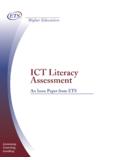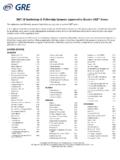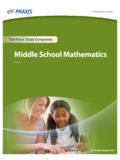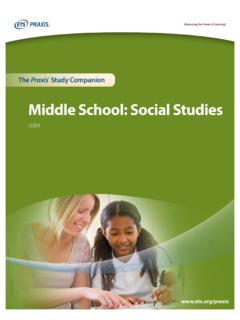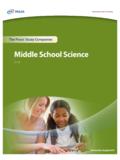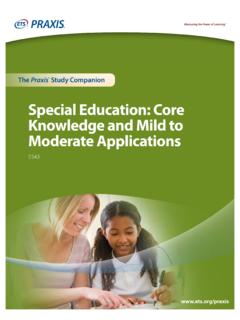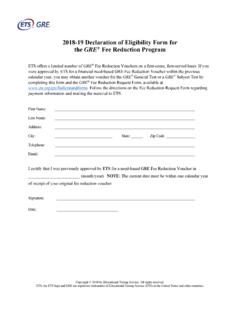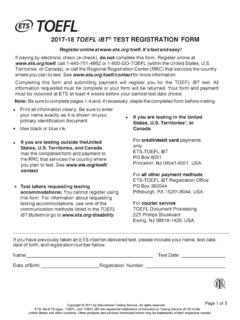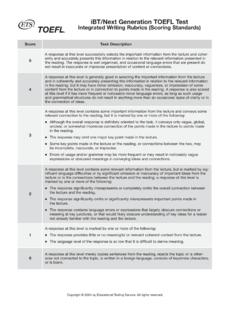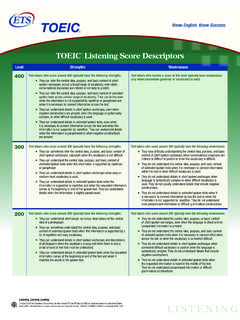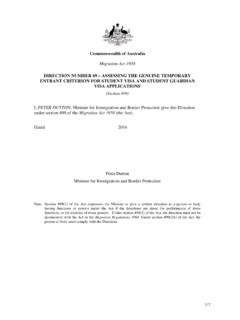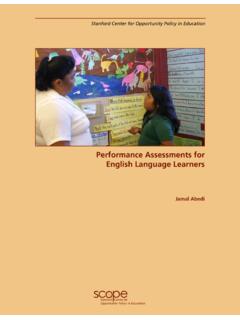Transcription of STUDENT PERCEPTIONS OF LEARNING AND …
1 TMSTUDENT PERCEPTIONS OF LEARNING AND INSTRUCTIONAL EFFECTIVENESS IN COLLEGE COURSES A VALIDITY STUDY OF SIR II John A. Centra and Noreen B. Gaubatz When students evaluate course instruction highly we would hope it is because the instruction has produced effective LEARNING . This tenet is in fact the basis for many validity studies that have been conducted with STUDENT evaluations of courses and teachers. A study in the mid-1970s with the original STUDENT Instructional Report (SIR) is a good example of a validity study that compared ratings to estimates of STUDENT LEARNING . Final exam scores from seven courses were correlated with STUDENT ratings from the SIR (Centra, 1977).
2 The global ratings of teaching effectiveness and value of the course to the STUDENT were the items most highly correlated with STUDENT achievement: 8 of the 14 correlations were .60 or above. In an introductory psychology class, for example, the overall rating of teaching effectiveness across 22 sections taught by 9 teachers correlated .63 with mean STUDENT achievement on the common final exam. That exam, as well as the exams in the other six courses studied, was made up by department members not teaching the course that semester. Moreover, students had generally been assigned to sections in two of the seven courses on a random basis, thereby controlling for another possible effect on the results.
3 In addition to the high correlations of exam scores with overall teaching effectiveness and course value, ratings of Course Objectives and Organization (a four-item factor) and the quality of lectures (a single item) were also fairly well correlated. Modestly correlated with final exam scores were Teacher- STUDENT Relationships (five items) and STUDENT effort (one item). Many additional studies during the late 1970 s and 1980 s have investigated the extent to which differences in STUDENT achievement (exam performance) in courses taught by different instructors are reflected in ratings of instruction. Referred to as multisection validity studies, meta-analyses of these studies have concluded that overall ratings of teachers or courses have a significant correlation (typically around.)
4 50) with end of course exam scores (Cohen, 1981, 1986; Feldman, 1989). Other ratings, such as for teacher- STUDENT interactions or course difficulty, typically correlate more modestly with exam scores. STUDENT PERCEPTIONS of LEARNING Although final course examination scores have been the primary criterion for establishing the validity of STUDENT evaluations, the scores reflect only a limited view of STUDENT LEARNING outcomes. More comprehensive indicators of STUDENT LEARNING would go beyond a single exam score, which typically reflects only narrowly defined course objectives. Such indicators might include STUDENT PERCEPTIONS of their increase in interest in the subject, critical thinking skills, interpersonal outcomes ( cooperative abilities), intrapersonal outcomes ( self-understanding) and other broad course outcomes (Koon and Murray, 1995).
5 In fact one study found that STUDENT PERCEPTIONS of LEARNING in a course correlated much higher with STUDENT ratings of instruction than did differences in pre- and post-test scores (O Connell and Dickinson, 1993). Ryan and Harrison (1995) and Cashin and Downey (1992, 1999) also found that STUDENT PERCEPTIONS of LEARNING were highly correlated with their overall ratings of teaching effectiveness. Another advantage of STUDENT PERCEPTIONS of LEARNING over final course examination scores is that the latter are limited to multisection courses that use a common final exam. These are typically first year introductory courses.
6 STUDENT PERCEPTIONS of LEARNING can be studied across a wide variety of courses, thereby making the results more generalizable. The Course Outcomes Scale of SIR II One of the additions to the STUDENT Instructional Report in 1995 was the scale of Course Outcomes. This scale includes five items that assesses more comprehensively STUDENT PERCEPTIONS of their LEARNING in a course, and thus can provide an excellent criteria for examining the validity of STUDENT ratings on other SIR II dimensions. students respond to each of the five items on a five point scale ranging from much more than most courses to much less than most courses (with a not applicable option available).
7 Two of the items reflect STUDENT PERCEPTIONS of LEARNING of course content: My LEARNING increased in the course, and I made progress toward achieving course objectives. A third item asked students whether their interest in the subject area has increased, which is the kind of outcome that a final course examination usually does not assess, but yet most instructors would desire as a course outcome . Similarly, in most courses instructors hope that students have been helped to think independently about the subject matter, so a fourth item elicits this rating. The fifth item asks students the extent to which the course actively involved them in what they were LEARNING .
8 Given the overwhelming evidence on the importance of active LEARNING in college courses, this last item reflects a critical instructional methodology as well as a course outcome (Bonwell and Eison, 1991). The five items on the Course Outcomes scale, therefore, reflect a broad set of LEARNING outcomes well beyond examination performance. Purpose and Questions to Be Addressed The purpose of this study is to investigate the relationships between STUDENT PERCEPTIONS of LEARNING as assessed by the Course Outcomes scale of SIR II and other instruction-related scales and items within the instrument. Do students who rate instructors and instruction as more effective also give higher ratings to LEARNING outcomes?
9 What is the role of STUDENT Effort and Involvement, another of the new scales added to SIR II, in STUDENT LEARNING ? Is the relationship between STUDENT ratings of instruction and STUDENT PERCEPTIONS of LEARNING modified by faculty and class variables ( academic rank, status, gender, level of course, and class size)? How does the relationship differ by institutional type, predominant pedagogy of the instructor, and academic discipline? Answers to these and other questions will provide a better understanding of the instrument and how its items and scales relate to a broad description of STUDENT LEARNING beyond final course examination performance.
10 And on a more general level the study results will help illuminate the many aspects of effective college instruction. Method The SIR II contains 40 items that deal with various aspects of instruction, including a single overall evaluation item (see Appendix A). The first four scales are similar to those in the original SIR, although many items have been added and others deleted or changed. Also, students are asked to respond to each item as it contributed to their LEARNING in the course. A five-point scale ranging from Very Effective to Ineffective is used; the original SIR used a four-point Agree/Disagree scale.
